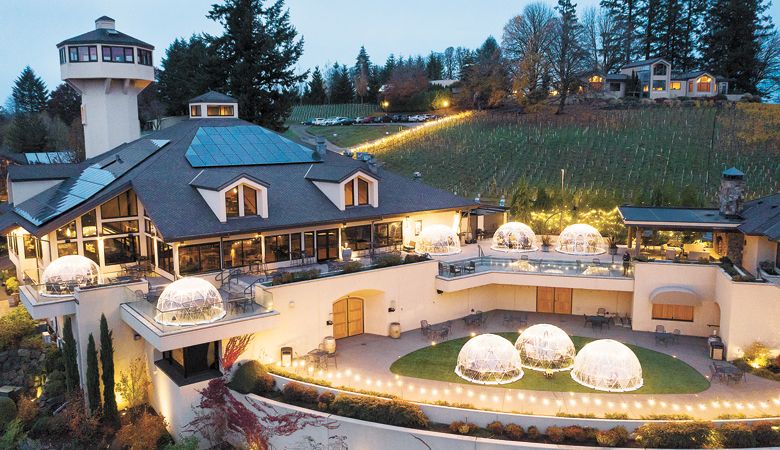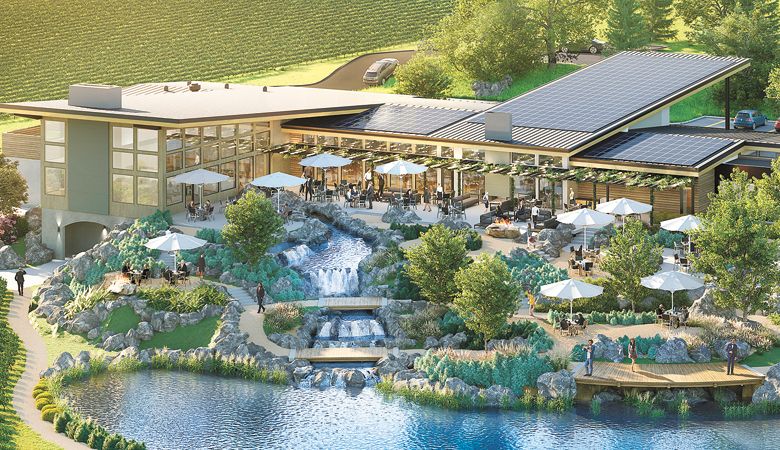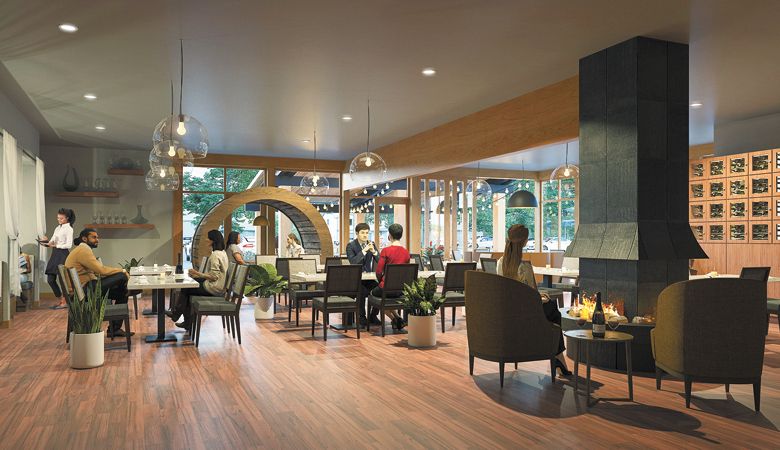2021 OWP Person of the Year: Jim Bernau
With community and innovation in mind, Willamette Valley Vineyards continues to lead Oregon
It’s tough to beat Jim Bernau for longevity in the local wine industry. Long before he founded Willamette Valley Vineyards (WVV) in 1983 — before he began shaving or even learned to drive — he made his first batch, fermenting Concord grape juice he snuck from his mom’s freezer.
His can-do spirit has served him well over the intervening years; likewise, his achievements have helped advance the Oregon wine world for nearly four decades, including over the last bustling year. Bernau’s list of current projects, during a pandemic no less, is what has earned the industry leader the Oregon Wine Press 2021 Person of the Year.
Bernau’s leadership and innovations continue to make a major impact on Oregon viticulture and winemaking. In fact, OWP isn’t the only publication heaping accolades on the man: Portland Business Journal named him 2021 Executive of the Year, and only five years prior, Wine Enthusiast nominated him for Person of the Year in 2016.
Not only can you find Bernau and WVV in print, but broadcast, as well. Most recently, Bernau appeared on local news, announcing his plan to pay farm workers overtime and raise their wages. In addition, this summer, the winery made an appearance on national TV, as Bravo’s “Top Chef: Portland” aired its season finale at the Turner estate.
Meanwhile, as the pandemic persists, WVV has perfected the pivot but with innovation in mind, of course. The winery has accommodated the “new normal” with transparent domes placed on the estate’s outdoor terraces, ensuring four-season hospitality.
Inside the winery, guests can witness yet another clever creation: WVV’s Pinot Noir Clonal Blending Experience. Guided by a winery ambassador, up to eight participants can blend their very own Pinot; the system documents the blends for customers’ future reference.
Innovation abounds behind the scenes, too. During the summer of 2021, WVV teamed up with Saga Robotics, Cornell University and USDA scientists at Oregon State University to introduce ultraviolet light technology in the vineyards to combat powdery mildew.
You might think Bernau has earned some rest, but he’s just getting started. Tireless in his mission to spread the word about the magic and mystery of Oregon wine, he keeps plenty of irons in the fire.
OWP had a conversation with him about what’s coming at WVV, his past accomplishments and the values of the Oregon wine industry, generally and the winery specifically.
Taking It on the Road
A recurring expression in our conversation, “taking it on the road,” also can be found on the company website. He first uttered the phrase when discussing the various expansions WVV has accomplished, are on the drawing board or are under construction.
In addition to the Turner estate, WVV has established a number of tasting rooms, including Tualatin Estate Vineyard in Forest Grove, downtown McMinnville and Maison Bleue in Walla Walla, Washington. Bernau says, “So, then we thought, ‘Okay, let’s continue to take this on the road, but let’s take it to places that aren’t just in wine country.’ So, we established a micro winery near Sacramento. I think it’s the first time an Oregon winery has actually established a winery presence in California; it’s kind of flowed the other way in our history.”
Called Willamette Wineworks in Folsom, California, the new winery represents just the tip of the proverbial expansion iceberg. Not only is Bernau taking wine on the road, but food, as well. In 2022, four tasting room/restaurants are expected to open, plus a much-anticipated sparkling estate that will present a pairing-inspired menu.
First, the bubbles. Domaine Willamette at Bernau Estate Vineyard in the Dundee Hills will be one of only a few Oregon wineries dedicated solely to world-class méthode traditionnelle sparkling wines. Expect local-inspired hospitality with food pairings, stunning views, educational tours and beautiful gardens, along with Biodynamically farmed grapes.
In four different cities, WVV will open its new culinary destinations. The Lake Oswego Tasting Room & Restaurant will feature an attractive trellis patio with an outdoor fire pit, a private wine cellar dining room, wine lockers and ample parking. The Vancouver Waterfront Tasting Room & Restaurant, located directly above the Maryhill Tasting Room & Bistro, boasts lofty views of the Columbia River. As the first Oregon winery represented among a cluster of seven Washington winery tasting rooms, it will include barrel booth seating, the barrel blending system and a spacious patio overlooking the river. The Happy Valley Tasting Room & Restaurant, just southeast of Portland, will feature a large outdoor patio and water feature. And lastly, look for another Tasting Room & Restaurant in historic downtown Bend.
Looking to the Future, Honoring the Past
When invited to share more about the sparkling wine project, Bernau immediately launched into the importance of respecting geographic names.
“If you go back and look at Oregon’s history and why Oregon has had so much success, some of the reasons are grounded in Oregon winemakers’ sensitivity and respect for others. The winemakers in France who have these powerful geographic designations have tailored their farms and winemaking rules to produce really high-quality [wines] and have attached their geographic designation names to those rules. For example, Bourgogne (Burgundy) and Champagne — those mean something as brands, as geographic-designated brands.”
In terms of the WVV sparkling project, Bernau Estate, he explains, “We now are calling the approach we’re using, which is fermented in the bottle, méthode traditionnelle.”
Why not méthode Champenoise? Bernau explains, “The French are saying, ‘Hey, please respect even the use of Champenoise.’ Of course, in Oregon, we have a law established in 1977 that was requested by the Oregon winemakers, which was about respect for other geographical designation names. That’s one of the reasons why the French took such a liking to Oregon winemakers; they were the first Americans to go to their government and say, we want to respect French law.
“You think about, what was one of the great tipping points in the development of high-quality wine in Oregon? It was the support of the French in providing our early winemakers with clones, and, of course, the predominant ones are the Dijon clones.”
Bernau remains dedicated to making superior sparkling wine, citing Oregon weather, which “gives us the opportunity to ripen Pinot Noir, Chardonnay and Pinot Meunier, and develop aromas and flavors in the fruit at lower sugar levels. That’s our relatively cool climate of the north Willamette Valley. When you make these sparkling wines, you’re picking grapes at like 18 Brix, far below your target of 24, let’s say, for making Pinot Noir.”
He continues, “And that is one of the north Willamette’s secrets that I think wine consumers are now discovering. Brian Croser and Rollin Soles were among the first to really tell that story well, through Argyle Winery. And now others are doing it, including ourselves with the help of people like Andrew Davis and others. For us, this is an exciting way to continue to tell the Oregon story. … Wine consumers around the world are just learning about what Oregon is capable of.”
Sharing the Story
Perhaps having been captivated by the stories told so eloquently by the powerhouse winemaking regions in Europe, Bernau fully recognizes the power of narrative to engage the minds, hearts and souls as well as the palates of wine drinkers.
Sharing the Oregon story and “taking it on the road” are foundational values for Bernau. He effortlessly weaves them together, too, referring back to the restaurant concepts, he says, “We are just beginning to tell the Oregon wine story through these tasting room/restaurants. We have like 272 employees now; we will have 500 employees in two years.
“Who knows what will happen? What kind of curve ball the economy will be throwing [in the future]? But if things go right, it’s possible that in 10 years, we could have 4,000 employees all out there telling the story of Oregon wine quality and Oregon’s values, which include respecting each other, collaborating with each other, and protecting and being good stewards of the land, as well as their communities.
“Why is it that Oregon wine is growing faster in sales in the United States than any wine grown in any other region of the country or the world? Well, I think it starts with what I mentioned before, the really high standards that were set right by our founders in 1977 and adherence to those standards of high quality, which has led to remarkable values that consumers receive in terms of quality and price. And consumers want to support winemakers who collaborate, who work together, who treat each other fairly, who support their communities and believe in the value of stewardship.”
Bernau continues, “We’re just beginning. People forget that the Willamette Valley is the size of the state of Connecticut. You go to Napa or Sonoma, these are small growing regions compared to just the Willamette Valley. And then you look at Oregon, the 10th largest state in the union, which has growing regions similar to Spain, or similar to Italy, or similar to Bordeaux, or the Rhône. We have them all. We’re just a little part of it and just love being a part of it.”
Upholding Core Values
Having covered the respect and sensitivity the nascent Oregon wine community displayed for geographic designated brands, the conversation turns toward other ideals, especially sustainability.
“We’re actually one of the founders of LIVE, and are deeply devoted to the program.” LIVE is a third-party independently certified set of sustainable practices for winegrowers in the Pacific Northwest. In addition to focusing on responsible stewardship of the land, it also values community and social issues such as worker health, and safety and good neighbor policies.
“That’s probably the one thing that I value the most: my colleagues giving me their founder’s award. I think it was the very first program of its kind in U.S. agriculture. Oregon now has among the highest percentage of vineyards in the world that are sustainably certified under such strict conditions. It’s just something that we think is really needed, and hopefully, we’ll continue to spread the good word.”
The values of stewardship and community take us to another tangent: the importance of using natural cork in bottles as cork forests in the Mediterranean sequester carbon. Bernau explains, “I believe the cork forests of the Mediterranean are second only to the Amazon in their importance.” The cork industry also supports hundreds of villages and protects habitat for the endangered Iberian lynx.
--------------------------------
It’s a good thing Bernau has abundant energy. He’s not one to sit on his laurels, many of which we haven’t even mentioned yet: Oregon’s first crowd-funded business. The first publicly traded winery. A game-changing partnership with Oregon State University and the Oregon Legislative Assembly to launch a world-class fermentation science program. The list goes on…
Terms like maverick, visionary and go-getter stumble toward cliché territory, but in Jim Bernau, they’re chapter headings in his accomplished life stories, all worthy of further exploration.


















